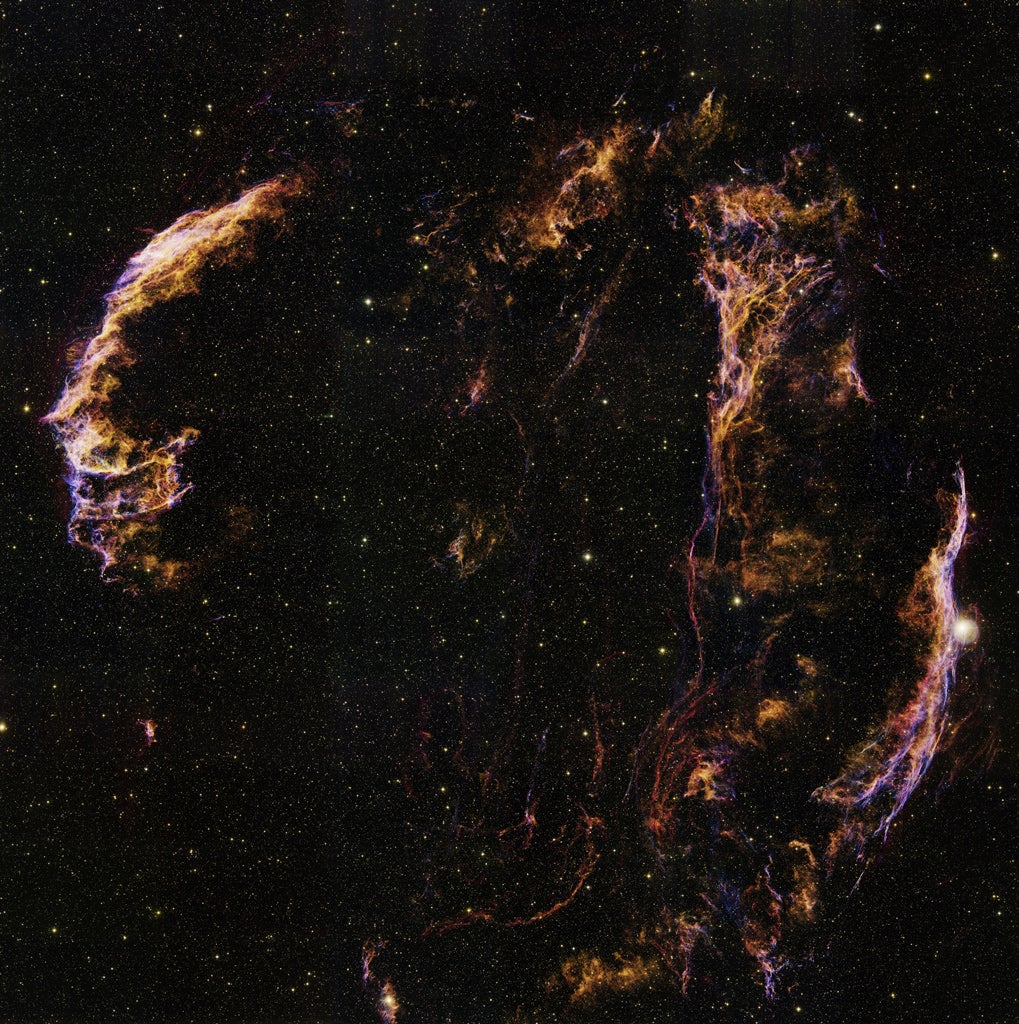The Cygnus Loop is a large supernova remnant — the gaseous remains of a massive star that exploded long ago. It is located about 1,500 light-years from Earth in the direction of the constellation Cygnus the Swan. Astronomers estimate that the supernova explosion that produced the nebula occurred between 5,000 and 10,000 years ago. First noted in 1784 by William Herschel, it is so large that its many parts have been cataloged as separate objects, including NGC 6992, NGC 6995, and IC 1340 along the eastern (left) side of the image; NGC 6974 and NGC 6979 near the top-center; and the Veil Nebula (NGC 6960) and Pickering’s Triangle along the western (right) edge. The bright star near the western edge of the image, known as 52 Cygnus, is not associated with the supernova.
The data were obtained with the NOAO Mosaic 1 camera, with observations in the Oxygen-III (blue), Sulphur-II (green), and Hydrogen-alpha (red) filters. When mounted on the WIYN 0.9-meter telescope, the Mosaic camera has a 1 square degree field of view. The Cygnus Loop was observed with nine separate telescope images in a 3 by 3 grid pattern.
The observations were originally obtained in 2003 by Richard Cool while he was a graduate student at the University of Arizona as part of a project to precisely measure the distance to the Cygnus Loop. Cool, now at the MMT Observatory in Arizona, said, “Often, astronomical research reduces images to dry tables of numerical information that we analyze in order to more deeply understand our universe. Images like this are amazing because they can remind you of the big picture and beauty that surrounds us.” In 2003, the computing power available was insufficient to process the data into a single, full-resolution color image. Nine years later, the data were re-reduced and processed by Travis Rector to create the image presented here.
Images like this demonstrate that even relatively small telescopes are capable of producing cutting-edge research when equipped with modern cameras.
The Cygnus Loop is a large supernova remnant — the gaseous remains of a massive star that exploded long ago. It is located about 1,500 light-years from Earth in the direction of the constellation Cygnus the Swan. Astronomers estimate that the supernova explosion that produced the nebula occurred between 5,000 and 10,000 years ago. First noted in 1784 by William Herschel, it is so large that its many parts have been cataloged as separate objects, including NGC 6992, NGC 6995, and IC 1340 along the eastern (left) side of the image; NGC 6974 and NGC 6979 near the top-center; and the Veil Nebula (NGC 6960) and Pickering’s Triangle along the western (right) edge. The bright star near the western edge of the image, known as 52 Cygnus, is not associated with the supernova.
The data were obtained with the NOAO Mosaic 1 camera, with observations in the Oxygen-III (blue), Sulphur-II (green), and Hydrogen-alpha (red) filters. When mounted on the WIYN 0.9-meter telescope, the Mosaic camera has a 1 square degree field of view. The Cygnus Loop was observed with nine separate telescope images in a 3 by 3 grid pattern.
The observations were originally obtained in 2003 by Richard Cool while he was a graduate student at the University of Arizona as part of a project to precisely measure the distance to the Cygnus Loop. Cool, now at the MMT Observatory in Arizona, said, “Often, astronomical research reduces images to dry tables of numerical information that we analyze in order to more deeply understand our universe. Images like this are amazing because they can remind you of the big picture and beauty that surrounds us.” In 2003, the computing power available was insufficient to process the data into a single, full-resolution color image. Nine years later, the data were re-reduced and processed by Travis Rector to create the image presented here.
Images like this demonstrate that even relatively small telescopes are capable of producing cutting-edge research when equipped with modern cameras.










